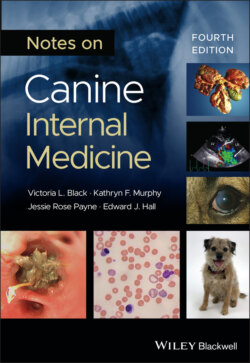Читать книгу Notes on Canine Internal Medicine - Kathryn F. Murphy - Страница 9
ОглавлениеPREFACE
“When you hear hoofbeats, look for horses — not zebras.”*
In 1983, in the first edition of Notes on Canine Internal Medicine, Peter Darke provided a revolutionary new and simplified diagnostic approach to internal medicine problem solving. It was not long before his book was to be found in the pocket of every veterinary undergraduate in the UK, as well as being an important first source of information for practitioners. The second and third editions built on this success. However, it is now nearly 20 years since the third and last edition and, in that time, our knowledge of canine internal medicine and our ability to investigate and treat cases has grown almost exponentially. Standard internal medicine texts now often fill two large volumes, detailing the underlying pathophysiology that is essential to understand diseases fully. However, there remains a need for a concise text to aid students and busy practitioners.
Whilst we acknowledge the importance of pathophysiology in internal medicine, in first opinion practice knowing the three most likely differential diagnoses for a problem is of more use than knowing ten obscure and unlikely ones despite potentially similar pathophysiological mechanisms. Thus, in this book, we have provided separate lists of the ‘common causes’ of medical problems, and the ‘uncommon causes’. Our personal experiences and geographical location inevitably bias our opinions on what are the most common causes of any specific problem but please note that these two lists are in alphabetical order and not order of prevalence. We are also not indicating the relative incidence of specific problems seen in first opinion practice, although practitioners will already know that dermatological and GI problems are most common. Our opinions on what are the best approaches to a specific problem are based on the scientific evidence, where it is available, and on our personal experience.
This edition follows a similar pattern to the third edition, with sections on presenting complaints, physical findings, and laboratory abnormalities. We have added a new section on imaging patterns, and again finish with a section covering diseases of the major organ systems. The authorship has been expanded to ensure we have the expertise to cover all areas of internal medicine, including Peter Darke’s own discipline of cardiology. We have also included information on behavioural, dermatological and ophthalmological problems focused on where these are manifestations of systemic disease. We do not believe in a totally algorithmic approach as used in some texts and have highlighted key clinical clues which, when using the results of history‐taking, physical examination, laboratory tests and imaging findings, should guide the clinician’s investigation in the right direction and avoid unnecessary testing.
As noted in the first edition, the recognition that not everything in internal medicine is black and white is part of its challenge; and not every patient ‘reads the textbook’. We still believe in the advice of the first edition that ‘basic, careful history‐taking and thorough and, if necessary, repeated clinical examination are fundamental procedures that may yield a diagnosis in a complicated or unresolved case’. One should always remember that there is always one more question to be asked, or one more investigation to be performed on problem cases, and one should never be afraid to go back to the beginning and start again.
V.L.B, K.F.M., J.R.P. and E.J.H.
2022
Note
1 * Source uncertain; https://quoteinvestigator.com/2017/11/26/zebras/
